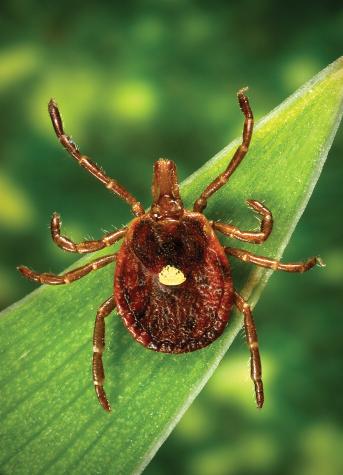COLUMBIA, Mo. – There’s a new University of Missouri Extension guide to discuss one of summer’s old pests.
“Guide to Ticks and Tick-Borne Diseases” is part of a series of manuals on integrated pest management from MU’s Plant Protection Programs. The guide is available for $5 at county extension centers or as a free download at extension.missouri.edu/publications/ipm1032.
Ticks are second only to mosquitoes as transmitters of human disease, said Richard Houseman, MU associate professor and extension entomologist.
There are more than 800 species worldwide, including the common hard ticks, soft ticks and a third family consisting of a single African species.
Ticks eat only blood, and they can transmit pathogens acquired from one host when feeding on the next host. Adult female hard ticks can swell with blood to weigh 50 to 100 times their original weight.
Most hard ticks have a three-host life cycle, requiring a different host for each stage of development. The three hosts may be of the same or different species.
Development time from egg to adult may take 24 years for hard ticks and 10 years or more for soft ticks, Houseman said. Both sexes feed on the blood of a vertebrate host in all stages.
Soft tickets have varying life cycles. They usually feed repeatedly on the same animal or same family group in a nest.
Ticks spend 95 percent of their lives off of their hosts, Houseman said. They can withstand long periods of starvation, with some studies showing that they can survive more than a year without a host.
Ticks require moisture, which is why they are generally found in humid, cool environments. They find their hosts by “questing,” or climbing onto vegetation and clinging, head down, to grass or branches. They wait for a host to pass and then they latch onto the host.
Houseman said only six of the 800-plus known tick species are commonly associated with human disease in Missouri, and most of these are hard ticks.
To prevent being a tick host, Houseman recommends tucking pant legs into socks or taping them closed before going into tick-infested areas, and spraying tick repellent onto clothing and skin.
Check for infestation immediately after leaving a wooded area rather than waiting to feel a tick bite. Transmission of many diseases takes up to 24 hours of attachment and feeding, so prompt inspection is critical. Wash clothing immediately. While ticks can sometimes survive hot water, they can survive in a hot dryer for only an hour.
